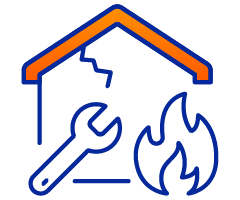Start Here
Homepage Bottom Form
We will get back to you as soon as possible.
Please try again later.
Fireproof Storage and Document Safety Guide
🔥 Fireproof Storage and Document Safety Guide
Created by House Fire Solutions – Protect What Matters Most Before, During, and After a Fire
When a fire strikes, your memories, identity, and financial security can disappear in minutes.
This guide helps you
safeguard critical documents, valuables, and irreplaceable records — before disaster happens.
Use this checklist to organize, secure, and protect everything essential to your home and family.
🧱 1. Start with an Inventory of What to Protect
☐ Create a list of all vital documents, valuables, and sentimental items.
☐ Separate items into categories:
legal, financial, medical, identification, property, digital, sentimental.
☐ Note where each document is stored currently (drawer, safe, file cabinet, or digital).
☐ Identify which items need
physical protection and which can be digitized safely.
☐ Keep both a printed and digital copy of your inventory list.
💡 Tip: Your inventory itself should be stored in a fireproof location or cloud backup.
🧾 2. Important Documents to Protect
☐ Birth certificates, marriage licenses, and adoption papers
☐ Social Security cards and passports
☐ Driver’s licenses and state IDs
☐ Property deeds, titles, and mortgage papers
☐ Vehicle titles and registrations
☐ Homeowners’ or renters’ insurance policies
☐ Health, dental, and life insurance documents
☐ Wills, trusts, and power of attorney papers
☐ Tax returns and financial statements
☐ Bank, credit card, and loan documents
☐ Business licenses, contracts, or permits
☐ Employment and income records
☐ Medical records and prescriptions
☐ Investment and retirement account details
☐ Education diplomas and certificates
💡 Tip: Make digital copies of everything and store them in an encrypted online drive.
🗃️ 3. Choose Fireproof Storage Solutions
☐ Select a
UL-rated fireproof safe (rated for at least 1 hour at 1700°F).
☐ Ensure the safe is
water-resistant for post-fire sprinkler or flooding protection.
☐ Anchor safes to the floor or wall to prevent theft.
☐ Choose a safe large enough for file folders and document envelopes.
☐ Opt for safes with
combination or digital locks, not keys (keys can melt or be lost).
☐ Store the safe in a
central, accessible location — not in the attic or basement.
☐ Label the outside discreetly (never mark it “SAFE” or “VALUABLES”).
💡 Tip: Safes rated “Class 350” protect paper documents from combustion; for digital media, use “Class 125.”
💾 4. Protect Digital Files and Data
☐ Scan and digitize all essential documents.
☐ Save digital copies to an
encrypted cloud storage (e.g., Google Drive, iCloud, Dropbox).
☐ Back up files regularly to a
fireproof external hard drive or USB stored in a safe.
☐ Protect drives and devices in
fireproof and waterproof pouches.
☐ Encrypt sensitive files (financial, legal, medical) with strong passwords.
☐ Maintain a written backup password list — sealed and stored in your fireproof safe.
💡 Tip: Use at least two backup methods — one physical (safe) and one digital (cloud).
🧍♂️ 5. Assign a Trusted Contact or Executor
☐ Choose one family member or trusted friend to know where important items are stored.
☐ Provide them with emergency access instructions and safe combinations.
☐ Make sure your executor or power of attorney knows the location of legal documents.
☐ Review this information with them annually or after major life changes.
💡 Tip: Don’t share your safe code via text or email — use a sealed envelope or secure note system.
🏠 6. Create a Fireproof Document Binder
☐ Use a
fire-resistant document pouch or binder rated for 1800°F or higher.
☐ Store key papers like IDs, policies, and medical info in sheet protectors.
☐ Label sections by category (Identification, Financial, Property, Insurance, etc.).
☐ Keep a printed contact list for insurance, banks, and family members.
☐ Add USB drives or memory cards in fireproof sleeves within the binder.
☐ Place the binder inside your fireproof safe for double protection.
💡 Tip: This binder should be light enough to grab quickly during evacuation.
💳 7. Secure Financial and Insurance Information
☐ Store bank account information, passwords, and contact numbers securely.
☐ Keep copies of insurance declarations and claim contact sheets.
☐ Document policy numbers for
home, auto, life, and health insurance.
☐ Store a photo of each card (insurance, ID, debit, etc.) in an encrypted file.
☐ Review and update policies annually.
💡 Tip: Having your insurance documents fireproofed speeds up recovery after a disaster.
💍 8. Protect Valuables and Sentimental Items
☐ Keep small valuables (jewelry, watches, heirlooms) in a fireproof safe or lockbox.
☐ Use
fireproof pouches for photos, USB drives, or small collectibles.
☐ Store irreplaceable family photos in both digital and physical formats.
☐ Photograph or video all valuables for proof of ownership.
☐ Record serial numbers and appraisals for jewelry and antiques.
💡 Tip: Store heirloom items separately from daily-use safes — in a long-term protection box.
📦 9. Off-Site and Cloud Storage Options
☐ Consider a
safe deposit box at a bank for originals (wills, deeds, birth certificates).
☐ Keep duplicates at home for quick access.
☐ Store digital files with two providers (e.g., Google Drive + external hard drive).
☐ Share read-only access to cloud backups with trusted contacts.
☐ Regularly test your digital backups for file corruption.
💡 Tip: Use encrypted naming for files to protect privacy if your cloud is ever compromised.
📅 10. Maintenance & Review Schedule
☐ Review your fireproof storage every
6–12 months.
☐ Update expired documents or outdated information.
☐ Test digital backups and password access quarterly.
☐ Replace fireproof pouches or safes if damaged or moisture-compromised.
☐ Confirm all trusted contacts still have accurate access information.
☐ Rehearse where your fireproof binder and safe are during fire drills.
💡 Tip: Add this checkup to your annual home safety calendar.
🔁 11. After a Fire: What to Do if Documents Are Damaged
☐ Do
not throw away partially burned or wet documents — some can be restored.
☐ Place wet papers in plastic bags and freeze them to prevent mold.
☐ Contact a
document restoration company for recovery.
☐ Request replacement copies from issuing agencies (DMV, banks, IRS, etc.).
☐ Photograph all damaged items for insurance claims.
☐ File a “proof of loss” form with your insurance provider including document replacement costs.
💡 Tip: Keep digital photos of damaged items — insurers often approve claims faster.
🧠 12. Final Notes for Homeowners
☐ Store all replacements (new IDs, titles, or deeds) in your fireproof binder.
☐ Back up your new records digitally within 24 hours
☐ Share updates with your insurance agent or recovery advisor
.☐ Keep yourHouse Fire Solutions™ Recovery Folder current and accessible.
☐ Remember: Protecting documents protects your recovery timeline and peace of mind.
Our Team Helps You Navigate Insurance, Restoration, and Rebuilding
It is a long established fact that a reader will be distracted by the readable content of a page when looking at its layout.

Board-Up
Our Network of Board Up Specialist Will Secure your property fast

Temp Housing
We'll Help You Find Safe Shelter while you recover

Public Adjusters
Our Network of Fire Damage Adjusters Will Fight Help for a fair insurance payout

Investors
Our Partner Specializes in Buying Fire Damaged Homes So you Can Sell your home as-is

Content Cleaning
Restore what matters most

Restoration
Bring your home back to life

Attorneys
We have a network of Protect your rights and claims

Mental Health
Support for you and your family
Want To See If We Can Help You
If you'd like to speak with us today about purchasing Social Security, Personal Injury, Workers' Compensation or Employment Law Leads.
Homepage Bottom Form
We will get back to you as soon as possible.
Please try again later.